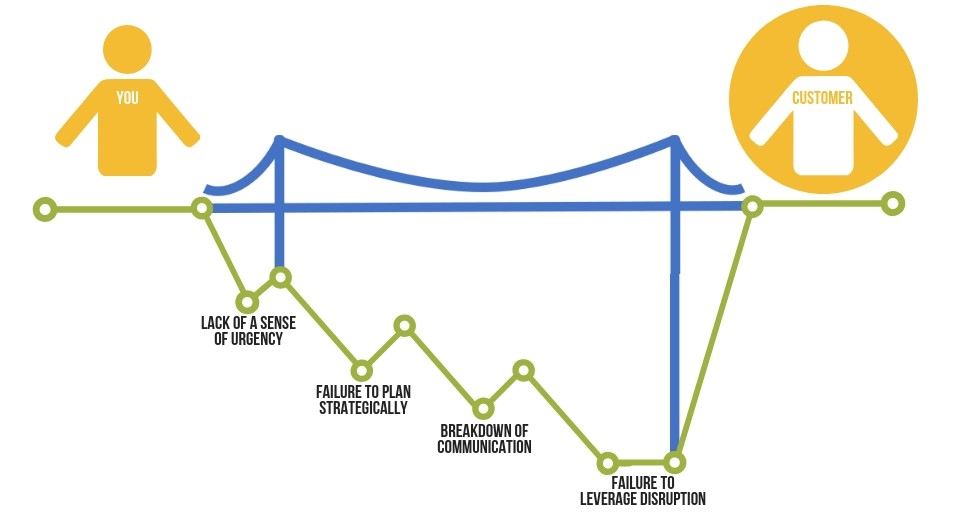
Protect Your Customers by Avoiding These 4 Common Mistakes
You know something isn’t right. We have all had this gut-feeling. You might recognize that things have changed or that something is about to happen, but you don’t know exactly what or even why. Maybe it’s a decline in sales or something monumental occurring in an adjacent industry. Some may ignore it, blissfully pretend that it’s just a little change or that the storm will pass, but if you’re not careful—before you’re willing to accept it—disruption may hit that could cause your customers to defect.
Letting disruption sneak up on your business without being equipped is dangerous. Disruption can be unpredictable, but knowing how to navigate through it doesn’t have to be. Avoiding these four common mistakes early can help your company’s disruption journey go more smoothly:
1. Lack of a Sense of Urgency
Acting too slowly can leave customers feeling abandoned and confused. Whatever the reason for procrastination, you can overcome each of these delays.
⇒ Is your team paralyzed by fear? If so, shift your team’s focus on uncovering opportunities and mitigating risks. Seeing disruption as an opportunity instead of a catastrophe allows your business to show off what you’re capable of achieving.
⇒ Are you sure your customer relationships are strong? Proactively investing into listening to your customers is the best way you can be sure. Deep customer listening initiatives provide invaluable data that can help indicate if disruption is coming, offer insight into vulnerabilities, as well as advise ways to lessen risk and capture new opportunities with customers.
2. Failure to Plan Strategically
Research suggests that over 70% of change efforts fail due to a lack of preparation.[1] Proactively working with your team to identify early indicators of disruption can help everyone see it coming. Evaluating various possible scenarios and figuring out how to adapt to each can make all the difference when preserving customers. It will allow your business to pivot more easily and become more resilient if, and when, the disruption occurs.
3. Breakdown of Effective Communication
Effective communication is critical in times of rapid change. With effective communication, customers (and employees) can avoid needless anxiety and loss of productivity. Because communication is a two-way street, you need both a plan for listening deeply to your customers and a plan for communicating your message. Failure to plan and target your message leads to inconsistency, confusion, and frustrated customers. Ask yourself:
⇒ Are you under-communicating? In times of disruption, over-communicate and build a communication plan that creates a bridge with your customer. People have to hear things multiple times in order for the words to sink in—especially when they are confused or anxious. Using as many methods as possible to connect can ensure that the message gets across.
⇒ Is there a system in place to listen? As we said, effective communication is more than merely transmitting your message. There needs to be a system in place to follow-up with your internal and external audiences to confirm that what they actually heard was correct and understood.
4. Failure to Leverage Disruption
It is good to stop and remember that change isn’t always a bad thing. Disruptions can uncover new opportunities that lead to powerful competitive advantages and reinforced relationships.
Customers become more loyal when we help them through tough times. By staying alert for signs of disruption, strategizing, and harnessing the power of change, your business and your customers can win even during times of disruption.
[1] Kotter, J. P. (1995). Leading change: Why transformation efforts fail.





